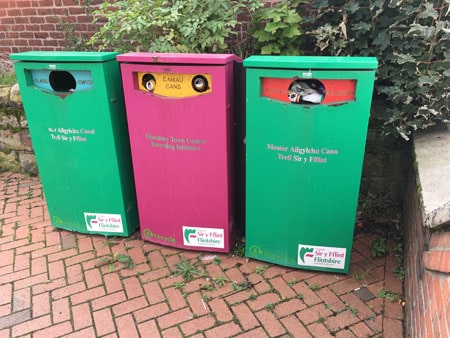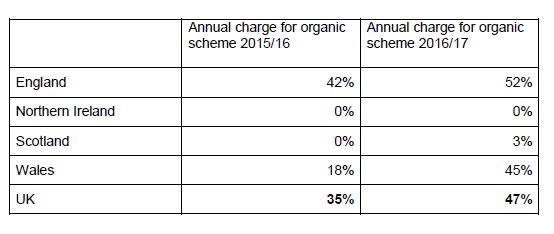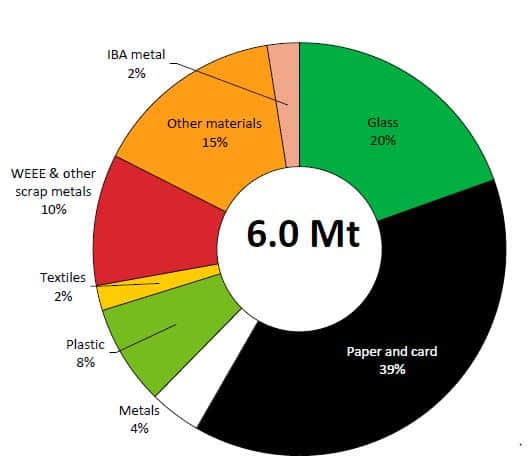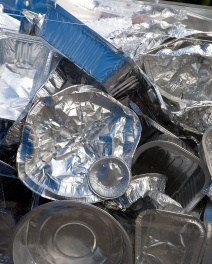A compendium of data published by the Department for the Environment, Food and Rural Affairs confirms that the UK narrowly missed the battery recycling target in 2016, that RDF exports reduced slightly in 2017 and the waste sector employs about 146,000 people.

The UK recycling rate in 2016 was 45.2% with Wales top at 67.3% (pictured: recycling bins in Flintshire)
The wealth of data in the document (published yesterday 24 May 2018) is collated by Defra using material from sources including the Environment Agency, UK and European data sources and resource charity WRAP. However, while the focus is on the UK, the landfill side of the UK’s waste management is potentially surprising illustrated by seagulls feeding voraciously on landfill waste in Croatia.
Most of the compendium is focused on 2016 figures with some of the data on a calendar year basis while some information is on a financial year basis.
It is reported that total Local Authority managed waste in 2016/17 was 26.1 million tonnes, up by 0.6 per cent on 2015/16 when it was 25.9 million tonnes.
In 2016/17 the cost of local authority waste management was around £3.4 billion in England. The cost excluding landfill tax amounted to just over £3 billion
Cost of local authority waste management covers net current expenditure on waste collection, recycling, waste minimisation, waste disposal (including landfill tax) and climate change costs. (Local authority collected waste is a combination of waste from households and waste from streets, parks and grounds and some business generated waste.)
Green waste
The increase in charging by local authorities for green waste is illustrated in chart below and the report also notes that the percentage of councils in Scotland and England remained static over the year compared to the year before. The percentage of local authorities operating the scheme in Scotland and England has remained the same over the last two years, but both countries have seen an increase in local authorities charging for the scheme.
In Wales garden waste collection is provided by all local authorities, but with 52 per cent of them charging for the service in 2016/17, up from 18 per cent in 2015/16.
Fewer local authorities in Northern Ireland operated an organic scheme in 2016/17 compared to 2015/16, but the collections are provided free of charge in all areas, notes the compendium.
IBA and recycling

Recycling material types in 2016: source Defra compendium
It also confirms that the UK recycling rate now includes the recycling of incinerator bottom ash metal from energy from waste plants. The UK waste from households recycling rate (including IBA metal) was 45.2 per cent in 2016, increasing from 44.6 per cent in 2015. This increase was seen in all UK countries, notes the document. The recycling rate for England was 44.9%, compared with 43.0% in Northern Ireland, 42.8% in Scotland, and 57.3% in Wales.
England, it is reported, is responsible for the “vast proportion of UK waste from households, generating 22.8 million tonnes (83% of the UK total) in 2016.”
In terms of dry recycling, about six million tonnes in 2016 came from households in England. And the statisticians report that the composition of dry recycling has remained similar since 2012 for many items.” Paper and card has seen a gradual decrease over time, and in 2016 accounts for 5.4 percentage points less of the total than in 2012, whilst the proportions of plastics and WEEE have each increased by 1.7 and 2.0 percentage points respectively in the last couple of years.”
RDF exports

RDF export figures: source Defra compendium
As expected, the Defra compendium confirms that in 2017 the export of refuse derived fuel stabilised and in fact fell marginally by 12,000 tonnes.
It is reported that the majority of refuse-derived fuel exported from England in 2017 was sent to The Netherlands (48%), Germany (20%) and Sweden (16.5%).
Employment
The significance of employment numbers in the sector is given with an estimated 146,000 people working in waste and recycling. However, Defra notes that employee numbers are estimated and “should be treated with caution”.
Breaking down the figures, approximately 72,000 work in waste collection, 38,000 in waste treatment and disposal, 20,000 in materials recovery, 10,500 in wholesale of waste and scrap and 5,500 in remediation activities.
In 2016 the number of employees involved in waste collection activities increased but in contrast, workers on the materials recovery side reduced.
Batteries
The compendium notes that the UK missed its collection targets for batteries recycling in 2016 achieving 44.95% compared to the target of 45%
Aluminium foil

Foil appears to be a problem area for recycling
Findings are also given for WRAP’s survey of the public in 2017 which found that almost two thirds of households (66%) express uncertainty over what can be put in the recycling bin. And over three quarters (76%) add one or more item to their recycling collection that is not accepted locally.
The largest number of people putting a material into the waste stream rather than recycling, in terms of material, was for aluminium foil with 26% putting it in “the general rubbish”. And the picture for aluminium foil is “getting worse”, says the document.
It is noted that the level of missed capture has increased for foil (from 21% in 2013), which appears to be the result of an increase in the number of local authorities that accept it, with not all residents aware and/or adopting it.
“By contrast,” says the compendium, “ there is less missed capture for aerosols – 20% could recycle this locally, down from 24% in 2014.”
Related links
Digest of Waste and Resource Statistics 2018 Edition
The post Defra compendium reveals RDF exports fall appeared first on letsrecycle.com.
Source: letsrecycle.com Waste Managment


